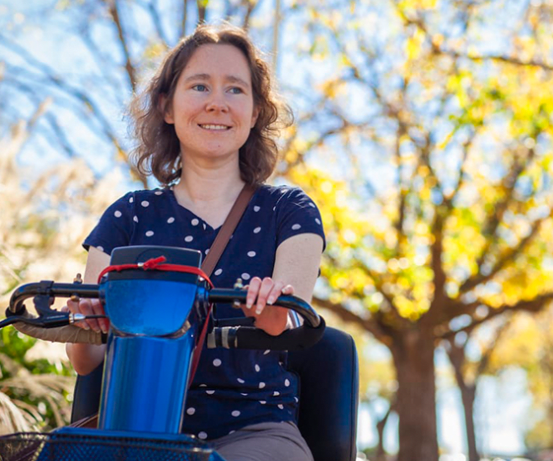How does a mobility aid fit into my NDIS plan?
Reduced mobility due to a disability and/or an injury can result in a loss of independence and more often than not it can affect the overall quality of life. Having the NDIS or other support funds to invest in a mobility aid has several benefits, such as reducing the risk of falls and injury, allowing for more independence, moving about with increased confidence and self-esteem, and can even help with the reduction of pain.
Being able to recognise and acknowledge the need for a mobility aid is the first step to exploring which mobility aid would best suit an NDIS participant’s special needs.
It may well be the time to consider a mobility aid if:
-
- You have injuries or impairments that cause an unbalanced gait
- You have limited lower body strength
- You experience pain when standing or walking
- You take medication that makes you feel dizzy
As part of the National Disability Insurance Scheme (NDIS), funds for mobility aids can be outlined in a participant’s plan.
Aids must help participants reach their goals and can include mobility aids and Assistive Technology (AT). AT covers a broad range of aids and supports the highest percentage of which is spent on mobility aids like manual/power wheelchairs and motorised scooters. To be eligible for funding for AT, it must be included as a specific type of support in a participant’s personalised NDIS plan. Even more importantly the AT must be related to a participant’s disability and must help in achieving the participant’s goals.
According to the NDIS Act 2013, a funded support ie. mobility aid must represent ‘value for money’. This means that the costs of the support must be
-
- Reasonable
- Relative to both the benefits/outcomes achieved
- The cost of alternative support
Above all, the funded support must be determined as being reasonable and necessary to suit the individual participant.
In the NDIS, supports fall into three categories :
Core NDIS supports
A support that enables a participant to complete activities of daily living and enables them to work towards their goals and meet their objectives.
Capital NDIS Supports
An investment, such as AT (assistive technology), equipment and home or vehicle modifications, funding for capital costs.
Capacity Building NDIS Supports
A support that enables a participant to build their independence and skills. Before we continue, let’s revisit the different support categories as set out by the NDIS. These supports are arranged into 15 categories that align to their purpose and the NDIA Outcomes Framework.
Core support purpose – Assistance with daily life, transport, consumables, assistance with social and community building participation.
Capital support purpose – Assistive technology; home
Capacity building support purpose – Coordination of supports; improved living arrangements, increased social and community participation, finding and keeping a job, improved relationships, improved health and wellbeing, improved learning, improved life choices and improved daily living skills.
Does the NDIS cover wheelchairs?
Participants often question if wheelchairs are an item that can be purchased using their personalised NDIS plan. For further reference and clarification, the individual will need to refer to the NDIS website for the specific selection criteria, policies and procedures relating to this matter.
It is important to note that mobility aids fall under Assistive Technology (AT) with your NDIS plan, and may be included in a participant’s plan if:
-
- It meets the ‘reasonable and necessary’ criteria
- It meets the participant’s needs
- It helps the participant to pursue their goals

Shop Mobility Aids
We’ve got you covered with our extensive product range.
Examples of Assistive Technology are:
- Higher risk AT items like manual/motorised wheelchairs, hand controls for a car, an adjustable bed
- An app that will help the participant to communicate if the participant has a speech impairment
- Special cutlery that can assist a participant to eat independently
As such, the NDIS will cover the cost of wheelchairs or mobility devices, provided it meets the above criteria.
Key Categories and Terms for Mobility Aids and the NDIS
Mobility aids ie. wheelchairs fall under the Capital support category under the heading Assistive Technology (AT) – a physical support that will help the participant to
-
- Do something more easily
- Do something the participant otherwise cannot do because of their disability
It is highly recommended to engage an Occupational Therapist (OT) who will be able to determine the right AT solution for a participant’s needs. AT can be grouped into two product risk categories – ‘low’ and ‘higher’ – to assess the complexity of a participant’s needs.
Low risk Assistive Technology products:
-
- Unlikely to cause harm in daily life
- Available for trial and/or can be purchased directly from retail stores
- Easy to set up and can be used safely without professional advice
Higher risk Assistive Technology products:
-
- Complex eg. a power wheelchair
- Known to have caused harm
- Used for a restrictive practice
- Requires professional advice, set up and/or training for safe use
It is important to note that the NDIS has different processes for low, mid and high cost AT. Seeking the services of a skilled OT to accurately determine the appropriate AT will benefit the outcome.
Costs for AT according to their product risk is as follows:
-
- Low cost AT – under $1,500 per item
- Mid cost AT – between $1,500 and $5,000 per item
- High cost AT – over $5,000 per item
In reference to the above, let’s explore how different cost items fit into different funding categories.
Low cost AT (under $1,500 per item) can include:
-
- Continence products
- Non-slip bath mats
- Walking sticks
- Basic shower chairs
Note: Core support – Consumables section – will show low cost AT funding.
Mid cost AT (between $1,500 and $5,000 per item) can include:
-
- Standing hoist
- Ankle-foot orthotics
- Pressure care mattress
- Customised shower chair
Note: Capital support will show mid cost AT funding.
High cost AT (over $5,000 per item) can include:
-
- Ceiling hoists
- Customised wheelchair
- Powered adjustable beds
- Complex communication devices
Note: high cost AT funding can also be found in the Capital support section. It will specify the type of AT that is being funded and will have ‘quote required’ as a reference. This funding is accessed only on the basis of an assessment and recommendation from a suitably qualified OT.
NDIS Consumables: What is covered?
Consumables are to assist participants with purchasing everyday use items. Consumables are a support category 03 and can be found under the CORE budget (Daily Living). Note – not all supports in this category is a consumable. However, continence, home enteral nutrition (HEN) and disability related health products ARE included in this category.
For more information, please see Consumables Code Guide (effective 1 March 2021) or visit Independence Australia’s dedicated NDIS consumables information page.
Certain low cost Assistive Technology (CORE support/category 03) up to the cost of $1,500 can also be claimed under consumables. Example of allocated funding can be for the purchase of basic (Level 1 eg. crutches) and standard (Level 2) AT which includes minor repairs to AT equipment eg. maintenance/repairs of a mobility scooter.
In conclusion and with reference to the above, participants are eligible to apply for mobility aids using their NDIS funding provided they are familiar with the selection criteria, policies and procedures as outlined above.
Written by Charmaine Idris
Charmaine has a spinal cord injury and self-manages her NDIS funding.
Her lived experiences as a paraplegic (23 years) has given her the insight and opportunity to pursue her dream of being an advocate and peer support leader with peek non-profit organisation Queenslanders with Disability Network (QDN) where she has significantly contributed to matters relating to PWDs (People with Disabilities) across a range of important topics that include housing, employment and the NDIS rollout. Working closely with the University of Sydney and with her fellow PWDs, Charmaine has made a valuable contribution in setting up DIDRR Australia (Disability Inclusive Disaster Risk Reduction in Australia)
Charmaine has recently engaged and worked closely with an OT to assist her in upgrading her current mobility (AT) equipment.
